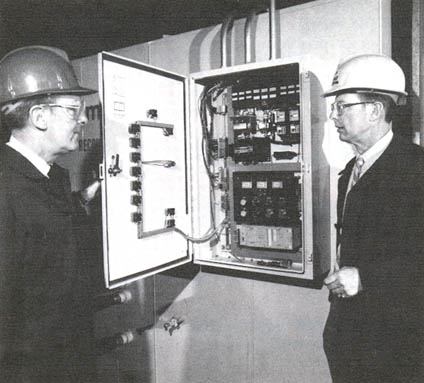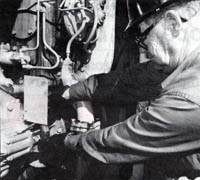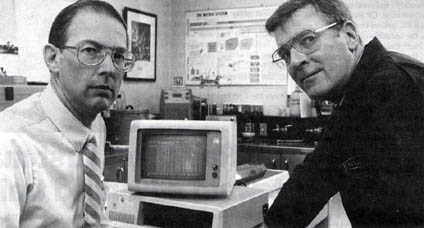Vol. 17 No. 5
May, 1987
|
Stay Safe in 87
|
|
Reclaiming Locomotive Oil Reaps Significant
Savings
By Michel Spenard

Zimmark System Economical: Doug Witherspoon, service
rep with Zimmark Inc. (left), and CP Rail's Ed Hannaford, supervisor of laboratory lubricant control at St. Luc Yard,
review the oil recovery system currently in use at the railway's Montreal
facility.
Montreal - The installation of a modern oil reclamation system at St. Luc Yard
here is producing significant economies for the railway.
The system, owned and operated by Zimmark Inc., of Burlington, Ontario, clarifies used locomotive oil through a
process of heat, the addition of a patented coagulant, and a settling process.
| |

CP Rail's Dennis Belanger takes an oil sample from locomotive
3108 for testing.
|
CP Rail has been evaluating the Zimmark system since 1985.
"Before the current large clarifier was installed last fall, CP Rail tested Zimmark's small oil clarifier for
one year", said CP Rail's Ed Hannaford, supervisor of laboratory lubricant control, at St. Luc Yard.
"The small machine could treat about 1,625 litres a week, and the quality of the reclaimed oil, as well as
the cost savings to the railway, was enough to prove that the system could work for us.
Today, as much as 10,000 litres of used locomotive oil is recycled at the yard every two weeks, he said, adding that
between November, 1985, and February of 1987, 117,000 litres of used oil was reclaimed using the new process.
Mr. Hannaford said one of the major economies of the Zimmark system is that even though the equipment is installed on
CP Rail property it is owned and operated by Zimmark.
"It's their service representative that monitors the automated process. All we pay for is the electricity and
the recovered oil we buy back. Clarified oil costs about half the price of new oil".
CP Rail personnel, meanwhile, regularly analyse the reclaimed product to ensure the reclaimed product continues to
meet the railway's specifications.
Prior to the Zimmark system, CP Rail used to re-refine its used locomotive oil. The major drawback with
the re-refining process was that it removed all of the original oil's additives. These would then have
to be added, making the re-refined oil more expensive than oil reclaimed with the current process.
The Zimmark process only removes a small portion of the original oil's additives. Currently, CP Rail is blending the
reclaimed oil with new oil on a one to 10 ratio when locomotives undergo an oil change or when oil levels in the
units need topping up.
"As our studies continue, we may increase the concentration of the cleaned oil to slightly higher blend rations
with the new oil", Mr. Hannaford said.
H.N. Aghjayan, CP Rail's supervisor, fuels and lubricants, said expansion of the Zimmark system to other diesel
shops will hinge upon the railway's tests of the effect of the process on the lubricant's additive composition, as
well as the potential financial benefits.
The oil reclamation process at St. Luc begins when one of the 250 locomotives serviced here arrives at the yard.
A compulsory oil sample from the locomotive is taken to the diesel shop laboratory for spectrographic analysis and
other testing. If abnormal levels of trace metals, or other contamination are found, indicating an engine problem,
the locomotive is sent to the shop for examination.
If repairs require that the engine oil be removed, the drained oil is segregated. Oil suitable for reclaiming is
then pumped to a storage tank for processing. On the average, about 11,400 litres of oil is processed at a time.
The lubricant is first heated to a temperature of 105 degrees Celsius to remove any water. A blower removes the
evaporating moisture through special ducting.
A chemical coagulant, patented by Zimmark, is then added and the oil is kept at a constant temperature to allow a
settling of remaining contaminants.
"The whole process is safer, cleaner, and much more efficient than the system used at this location by the
railway before", said Doug Witherspoon, Zimmark's service representative.
"The system installed at St. Luc is our most up-to-date. The operation is computer controlled and
uses enclosed air heaters, instead of immersion heaters, to maintain the oil's correct temperature", he said.
"With the controls available, one could simply say that used contaminated oil is pumped into the Zimmark tank,
treated, and pumped to the diesel shop oil storage tanks as easily as receiving new lube oil by truck
delivery".

CP Rail's Ed Hannaford (left) and Zimmark's Doug Witherspoon.
This CP Rail News article is copyright
1987 by the Canadian Pacific Railway and is reprinted here with
their permission. All photographs, logos, and trademarks are the property of the Canadian Pacific Railway
Company.
|